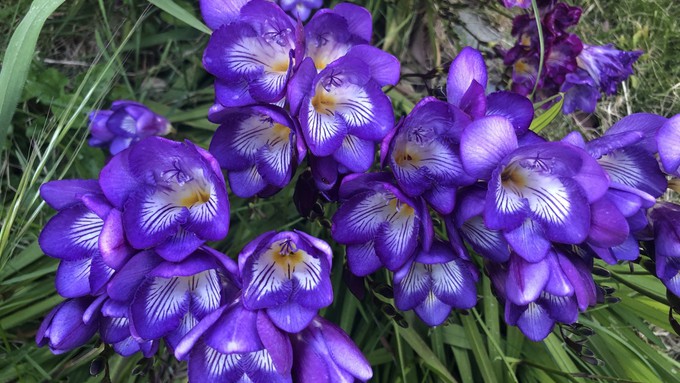
As Sacramento weather finally feels like spring, expect rapid changes in your garden

Enjoy spring flowers while you can. They'll be gone soon. Kathy Morrison
Is your garden ready for the 70s?
Sacramento temperatures are expected to warm up dramatically – at least for a few days. After a rainy (and very cool) Friday, Sacramento could see 78 degrees on Monday, according to the National Weather Service. We’ll also see a warm and sunny Easter Sunday with a predicted high of 76.
Normal for this week in Sacramento: 71 degrees.
But another cold front is expected to tamp down temperatures again midweek with a high of 64 degrees on Wednesday and overnight lows in the low 40s. Don’t worry if you just set out your tomatoes; the long-term forecast sees more 70s coming soon.
Usually, we’re hotter by now. On average, Sacramento sees its first 80-degree day on March 27. We haven’t topped 80 degrees all year. March 13 and 17 both recorded highs of 68 degrees, and that’s as warm as it got all month. On Feb. 12, we hit 72 degrees (and expected an early spring); that was our warmest day of 2023. It’s been kind of damp and chilly ever since.
So far, Thursday (April 6) was our warmest April day at 65 degrees – six degrees below normal for that date. Nights have also remained cold; four out of the first five nights in April dipped down into the 30s with one frost warning.
That’s kept the ground cold, too, and slowed growth of many young plants – including weeds.
So, if your early vegetables are just kind of sitting there and doing nothing, that’s why. Blame the weather.
That excuse will soon be gone. With this rapid warm-up, be ready for change:
* Enjoy the last days of spring-blooming bulbs. Our cool March extended the season for daffodils, tulips, freesias and other spring favorites. They’re fine in 70-degree weather, but will quickly fade as we approach 80 degrees. Cut some bouquets to bring indoors.
After they finish blooming, these bulbs still need water so they can finish their growth cycle. Their foliage is collecting energy for next spring’s flowers. Remove spent blooms, but keep the leaves attached until they yellow.
* Keep an eye on soil moisture. Recent rain may have dampened the mulch, but what about soil roots? Is there enough moisture where plants need it? Use a soil moisture meter or a trowel; dig down 6 inches and look.
* Container-grown plants can dry out quickly in warmer weather. Make sure to give them a drink.
* Watch seedlings and new transplants. Keep them evenly moist. Mulch will help insulate their roots.
* Attack weeds. Don’t wait; weeds love, love, love this weather – especially after a little rain.
* Be on the lookout for powdery mildew. This fungal disease is triggered by warmer weather; 72 degrees is its sweet spot. Examine rose leaves or foliage on other vulnerable plants such as peas. If you see an infected leaf, remove it immediately.
For more on powdery mildew: https://ipm.ucanr.edu/QT/powderymildewcard.html.
Comments
0 comments have been posted.Sacramento Digs Gardening to your inbox.
Food in My Back Yard Series
May 6: Maintain soil moisture with mulch for garden success
April 29: What's (already) wrong with my tomato plants?
April 22: Should you stock up on fertilizer? (Yes!)
April 15: Grow culinary herbs in containers
April 8: When to plant summer vegetables
April 1: Don't be fooled by these garden myths
March 25: Fertilizer tips: How to 'feed' your vegetables for healthy growth
March 18: Time to give vegetable seedlings some more space
March 11: Ways to win the fight against weeds
March 4: Potatoes from the garden
Feb. 25: Plant a fruit tree now -- for later
Feb. 18: How to squeeze more food into less space
Feb. 11: When to plant? Consider staggering your transplants
Feb. 4: Starting in seed starting
Sites We Like
Garden Checklist for week of May 4
Enjoy this spring weather – and get gardening!
* Plant, plant, plant! It’s prime planting season in the Sacramento area. Time to set out those tomato transplants along with peppers and eggplants. Pinch off any flowers on new transplants to make them concentrate on establishing roots instead of setting premature fruit.
* Direct-seed melons, cucumbers, summer squash, corn, radishes, pumpkins and annual herbs such as basil.
* Harvest cabbage, lettuce, peas and green onions.
* In the flower garden, direct-seed sunflowers, cosmos, salvia, zinnias, marigolds, celosia and asters. (You also can transplant seedlings for many of the same flowers.)
* Plant dahlia tubers. Other perennials to set out include verbena, coreopsis, coneflower and astilbe.
* Transplant petunias, marigolds and perennial flowers such as astilbe, columbine, coneflowers, coreopsis, dahlias, rudbeckia and verbena.
* Keep an eye out for slugs, snails, earwigs and aphids that want to dine on tender new growth.
* Feed summer bloomers with a balanced fertilizer.
* For continued bloom, cut off spent flowers on roses as well as other flowering plants.
* Add mulch to the garden to maintain moisture. Mulch also cuts down on weeds. But don’t let it mound around the stems or trunks of trees or shrubs. Leave about a 6-inch to 1-foot circle to avoid crown rot or other problems.